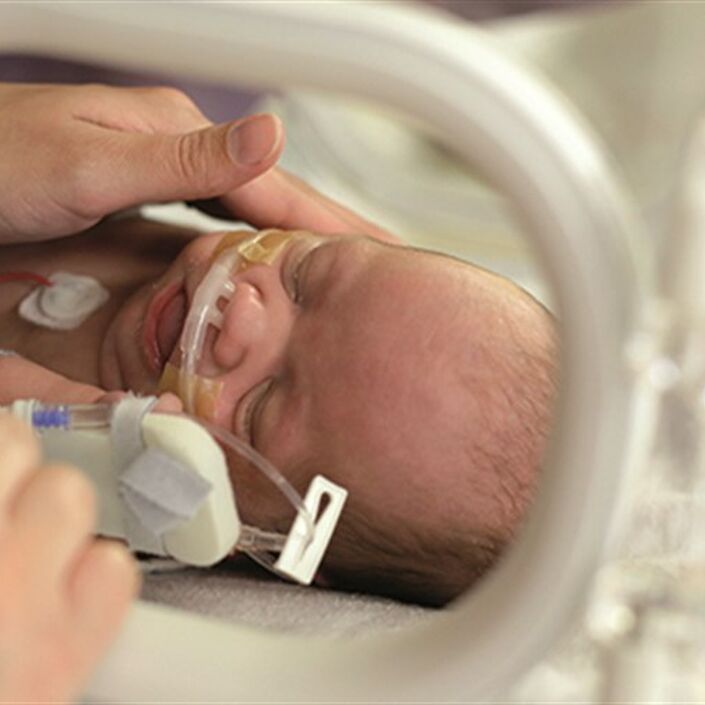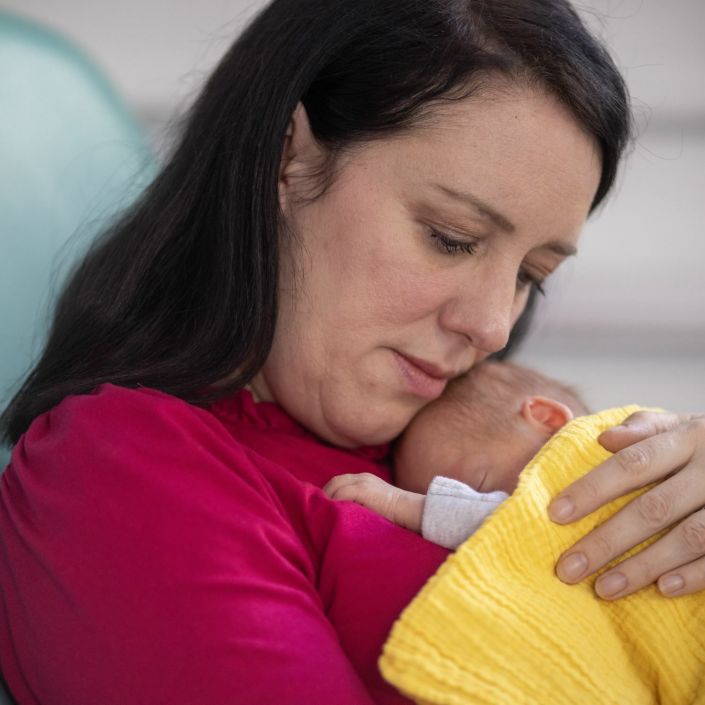Chronic lung disease (CLD) is a respiratory (breathing) condition. It is usually diagnosed in premature babies who need ongoing help and support with their breathing beyond 36 weeks corrected age (the date your baby would have been born if they had not been born early).
CLD and long-term breathing problems can also affect babies who need ongoing help and support with their breathing 28 days after birth. This includes some babies born at term. It is less common for babies born at term to be diagnosed with CLD.
You might hear CLD being called bronchopulmonary dysplasia, or BPD.
Sadly, some babies die of CLD. We have more information about making critical care decisions, palliative care and bereavement, and links to some more sources of support further down this page.
What causes CLD?
CLD commonly affects babies born premature. This is because babies who are born premature can have lungs that are immature and have not developed fully. If your baby has CLD, they may have had a condition called respiratory distress syndrome (RDS) shortly after they were born.
As babies with RDS have lungs that are immature, treatments used to treat RDS can cause scarring to the lungs. This includes ventilation and oxygen use. If your baby has been put on a ventilator for a long time, they are at a higher risk of developing CLD. You can find out more information about treatments used for RDS.
Some babies born at term can develop long-term breathing problems. This usually happens in babies with underlying health conditions. You may hear doctors refer to this as CLD or long-term lung disease. If you are unsure, speak to staff on the neonatal unit for more information.
What are the signs of CLD?
Your baby is likely to be diagnosed with CLD on the neonatal unit.
Doctors may suspect CLD in your baby if they were born at 32 weeks gestation or less and need oxygen or breathing support (such as a ventilator or continuous positive airway pressure) when they are at 36 weeks corrected age. Your doctor may talk to you about CLD before this. This is because CLD is a condition that develops over time.
If your baby was born after 32 weeks gestation, or was born at term, doctors may diagnose CLD if your baby needs ongoing breathing support at 28 days after birth.
What tests might my baby have?
Your baby may have some or all of the following tests to monitor their CLD:
- A chest X-ray
- This can be used to diagnose CLD and understand how severe it is.
- Monitoring, which includes pulse oximetry, heart rate and breathing tests – These are measured using sensors that are placed on your baby’s skin. Pulse oximetry measures how much oxygen is in your baby’s blood (also called blood oxygen saturation).
- Blood gas test – This is a blood test which measures your baby’s levels of oxygen, carbon dioxide, and acid in the blood. Doctors take blood from a heel prick sample. It can also be taken from a small plastic tube that is placed in your baby’s tummy button, hand or foot.
The treatment that your baby will have will depend on how severe the CLD is. Treatment that may be used include the following:
Continuous positive airway pressure (CPAP)
Continuous positive airway pressure (often shortened to CPAP) is a type of respiratory (breathing) support. It passes air with or without oxygen (depending on what your baby needs) through two thin tubes in your baby’s nose, or through a small mask over their nose.
CPAP slightly raises the pressure of the air, which helps keep your baby’s lungs inflated. During CPAP, your baby breathes on their own, but the machine helps to inflate the lungs in between breaths.
Oxygen therapy
Some babies will need some breathing support with oxygen therapy. Oxygen is usually given through a nasal cannula, which are small soft tubes that are placed in your baby’s nostrils.
Some babies will be given high flow nasal cannula oxygen. This is where babies are given warmed oxygen at a high flow through a nasal cannula (see above).
Medication
Babies with CLD may have the following medications:
- Diuretics, which can help reduce extra fluid in the lungs.
- Steroids, which can help reduce any inflammation in the lungs. This can help to improve lung function.
The healthcare professional looking after your baby can talk to you about the benefits and risks of these types of medication.
Mechanical ventilators
Mechanical ventilators are machines that do the breathing for your baby if they are unable to breathe on their own. They blow air with or without oxygen (depending on what your baby needs) gently into your baby’s lungs. This is done through a tube that is passed through the baby’s nose or mouth (called an endotracheal tube) into their trachea (windpipe).
There are two types of basic ventilator:
- Conventional ventilators blow air with or without added oxygen (depending on what your baby needs) gently into your baby’s lungs. This happens through a tube which is passed through your baby’s nose or mouth and inflates your baby’s lungs.
- High frequency oscillating ventilators blow small amounts of air with or without added oxygen (depending on what your baby needs) into the lungs very quickly, hundreds of times a minute.
Nutritional support
Babies with CLD may not gain weight as quickly as healthy babies. This is because they need more energy to breathe.
To ensure that your baby continues to grow and develop, they may be fed mothers own milk, formula or donor milk through a tube passed into your baby’s nose or mouth to their stomach. This is called tube feeding.
Some babies may also need to be fed using nutrition that is given in a liquid form directly into their bloodstream intravenously (into a vein). This is called parenteral nutrition (PN).
What happens if my baby has to go home on oxygen?
Some babies with CLD will be discharged from the neonatal unit on oxygen. This means their breathing will be supported by additional oxygen from a tank which is given to them through a tube in their nose.
Many babies with CLD will no longer need home oxygen within a year. We have more information about going home on oxygen.
If your baby has CLD, you may have questions about how it may affect them in the long term.
Most babies with CLD who remain healthy after they have been discharged from hospital show steady improvement with their breathing.
When a baby first comes home, ordinary coughs and colds may make them wheeze more than a baby without CLD.
If your baby has been discharged from the unit but they are still on oxygen, they are at higher risk of viral infections and conditions that affect the lungs, such as bronchiolitis, flu or pneumonia.
Your baby might need to go back into hospital for a few days to monitor their breathing or for more treatment. Sometimes babies need more help from a ventilator.
We have information about ways that you can help to prevent infection to help protect your baby, particularly during the winter months.
As babies with CLD may be more vulnerable to flu or flu-like illnesses, your GP may offer them the flu vaccine when they are at home from the neonatal unit and over 6 months old.
You may also be offered a vaccine called synagis (palivizumab), which protects them from developing serious effects from a virus called respiratory syncytial virus (RSV). For more information, talk to your baby’s GP or staff on the neonatal unit.



